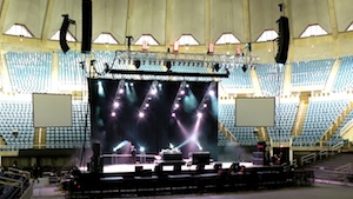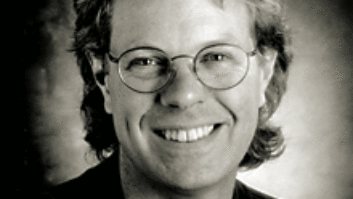Hollywood’s special effects wizards are experts at getting 600-pound gorillas to move onscreen, but when it comes to moving around 6 million-pound gorillas, Atlanta’s Crawford Communications deserves the Oscar.
Nearly three years ago, planners at the city’s Metro Transit Authority, MARTA, decided that they needed a new rail switching yard to accommodate the massive growth in the city’s rapid transit system to counter The Big Peach’s problematic traffic congestion.
Unfortunately, the specific site they determined to be most appropriate for the new rail yard — and absorbed under the aegis of eminent domain — was exactly where Crawford Communications had been in operation for the past 16 years. Founded in 1981 by company president Jesse Crawford, privately held Crawford Communications had built itself into the Southeast’s premier post-production facility, comprising 150,000 square feet and home to 300 employees servicing broadcast and film, audio and video post, multimedia and satellite transmission services. Network and cable broadcast clients include Turner, Tribune Co., The Learning Channel and Discovery; the company also regularly handles advertising and corporate work and independent film productions. Those operations had to be moved completely to a new location, and it all had to be done without interrupting business. And Crawford wasn’t going to be able to pull it off with special effects. Simply put, the entire facility would have to be moved — lock, stock and barrel.
“When they came to us, we were dumbfounded,” recalls Steve Davis, Crawford’s director of audio services. “Then the reality sets in: You can discuss the terms of the move, but you can’t argue with eminent domain.”
The company quickly set about developing a strategy for the move. The new site chosen by Crawford — on 26 acres that once housed commercial satellite dish manufacturing and research operations for Scientific Atlanta — was approximately 11 miles away from the original location, in the northeast section of the city but still near the I-285 perimeter that loosely defines Atlanta’s sprawl. At the time, it must have seemed like 11 light years away.
“The logistics were incredible,” says Davis, “but the strategy we developed was to stage the logistics, building rooms at the new facility, prewiring them and getting them as ready as they could be, room by room, then choosing a day, moving the equipment and setting it up in the new place. There were maybe a couple of days downtime between each room. But the key was to make sure that there were always rooms available for each project so that no clients were inconvenienced. As expensive as it might be to buy new equipment and technology, that can be managed and budgeted for, but lost revenues will eat you alive.”
LIFE HANDS YOU LEMONS, YOU MAKE LEMONADE
However, there was a significant silver lining to this situation, and once the shock of the realization wore off, Crawford’s management realized that it was being given a rare opportunity to reinvent itself at a time when the technological and business models of the professional audio/video post and broadcast industries were undergoing dramatic change.
Davis explains: “We had been experiencing a lot of growth over the years we had been here, and our response was to expand our operations. But as with any business, when you’re reacting to new requirements, you put new operations in where you have space, using the technology current at the time. So as you would expect, the audio rooms were all somewhat different, reflecting the time they were brought online. And our audio operations began at a time when people wanted more use of large-format consoles, so we had six rooms like that vs. five rooms with Pro Tools hard drive systems, which were used at that time for more basic services. All of this is compounded by the fact that in a market like Atlanta, you have to have the capability to service a wide range of clients and markets, as opposed to Hollywood, where there’s so much post work that you can pick a specialty like film audio and build an entire business based on it.”
The move allowed Crawford to develop an integrated new systems plan, smaller in size but exponentially more powerful and sophisticated. The plans called for a 135,000-square-foot facility with 11 new studios, including three large-format rooms designed by Tom Hidley. The principals also realized that they could take a more integrated systems approach to technology. The number of Pro Tools systems and suites increased, and the three large-format rooms were equipped with the same platform — Avant digital consoles from Solid State Logic — all of which are hub server-networked.
“You can really see how the business has changed,” says Davis. “There’s more emphasis on hard drive systems now, and they’re used for many more aspects of production, as well. And while there’s less reliance on large-format equipment, you can achieve a lot more using fewer consoles and rooms if you have consistent technology that’s also networked together. So the bottom line is, we end up with about the same number of rooms in the new facility vs. the old one, but the new ones are more efficient, more sophisticated and more productive.”
The benefits of the move accrued on the video side as well. Bill Thompson, Crawford’s VP of post-production, says that the facility was able to expand the number of its 601 nonlinear editing suites, designed by Atlanta-based architectural firm Alex Munoz & Associates, and, more significantly, increase the networking of all of its video operations from central servers. And perhaps just as importantly, he adds, “We were also able to upgrade the aesthetics of the suites. Four of our nonlinear editing rooms will have patios where clients can hang out on now and two have theater-style projection.”
A CHANGE WAS GONNA COME
Eric Stark, Crawford Audio’s chief engineer, created the schematics for the audio division’s new quarters, based on complete integration of all audio studios — six compact audio suites based on Pro Tools and Yamaha O2R mixers, two larger nonlinear suites equipped with Pro Tools, Fairlight MFX3plus workstations and Synclaviers, and three large control rooms, each with an SSL Avant console with integrated Pro Tools and MFX platforms. Wiring for all audio and video connections into a central server network was done by Sony’s SIC division.
“The rooms had to be able to transfer audio and files from any studio to any other studio,” says Stark, adding that each has its own Internet portals to support Crawford’s commercial client base for streaming voice-overs and approval versions. “We’d started the idea at the old place and expanded on it significantly here,” Stark says. “We wanted it so that you don’t have to get out of a chair to do anything. Included in the networking design are such touches as mic pre’s accessible and controllable from any of the large-format consoles, as well as video cameras linking all of those studios to allow both acoustical spaces to function as a single studio, if needed.
WITHOUT A HITCH
The actual transition between facilities was so meticulously planned that it almost seems anticlimactic in retrospect. It was a rolling transition, with sessions at times finishing the day in one location and picking up the next day at the new site, with all audio networks having their specific transitions over a two-hour period one Saturday afternoon, when one set of prewired hubs was activated and another shut down almost simultaneously.
“We had to sync all of their schedules and all of their data and media between one place and the other,” says Stark. “It was as much logistics as it was technology and design.” The satellite up-/downlink capability, a big part of Crawford’s business, was bridged by the company’s seven C- and Ku-band remote trucks, which acted as a bridge between the offlining and onlining of old and new satellite farms adjacent to the two sites.
As good as the technology for audio is, it’s matched by the video upgrade within the audio division; it includes DILA high-end projectors that allow emulation of a full range of environments, from big theaters to home theaters. That, says Davis, was an offshoot of Crawford’s deliberate and thorough market research in the two years they had to prepare for the move.
“We had to know where the market was going in 2001 two years ago,” Davis says. “Looking around, we could see that there was a congressional mandate for digital television. But there were other signs as well: DVD was becoming the fastest-selling new consumer entertainment format, and we saw the inserts in the Sunday papers advertising complete home theater systems at that magic $300 price point. We had to know where every part of the market was going to be, because this was an opportunity to get more deeply into markets we were already in and into new markets.”
Hence, Davis and Stark say, the emphasis was placed on the audio environments. For instance, Hidley’s control room designs take into account the fact that more music concert videos will be done on DVD, which offers more frequency range. Thus, so do the new control rooms, which can cover 16 to 22k Hz, using a combination of Kinoshita monitors and powered subs and surrounds that Stark designed and built (which he dubbed Krats — Stark spelled backward).
“It’s really a new concept for an audio post room,” Davis suggests. “It takes the best of a film dubbing room and a music studio and cherry-picks them into the optimum design for a room intended for mixing audio to picture. That allows us to target markets for the next generation of broadcasting; for DVD and home theater; for special-venue pieces, such as fixed installations in museums; and for long-form media work for entertainment and for corporate clients. Most of the audio-for-video work for these applications in the past have been done in small music-type control room environments, which are basically audio rooms where video has been added. Our new rooms have full front-projection systems capable of up to high-definition playback, as well as great monitoring and acoustic enhancements such as concrete-fill baffle walls. It’s a next-generation approach. Even in Hollywood, you see great dubbing stages, but they’re designed to emulate theater environments. They’re not designed for mixing a DVD music video. Theaters have perf[orated] screens; home theaters generally don’t. So we can cover a lot more bases for a lot more clients this way.”
Davis adds that more of Crawford’s corporate and broadcast audio clients, such as The Discovery Channel and PBS, have also come to realize the long-term benefits of content, so they are, in his words, “future-proofing” and repurposing their productions in post by adding multichannel sound, for example. Music videos and concerts have been spearheading this trend on DVD in the last two years, and it’s a market sector that Davis sees Crawford pursuing more intensely. As a result, all three large control rooms and two of the smaller audio suites are equipped for 5.1 audio.
As complex and costly as the move was — tens of millions of dollars between Crawford and the city, counting the valuations of the sites, technologies and labor — the transition was completed right on schedule. “We handed the keys over to MARTA on September 29,” Davis recalls proudly, a day before the stipulated last day of that month. It wasn’t an arbitrary deadline, he recalls. “On October 1, MARTA [was] going to have bulldozers waiting at our door,” he says. “So it would to be pretty dramatic if we didn’t have everything in place by that date.”
And, considering how cable television has consumed itself with programs recounting the creation of massive manmade works, from Cheops’ Pyramid to the Boulder Dam, one of these days it may come to see Crawford’s move as an opus worthy of the same treatment.
Dan Daley is Mix’s East Coast editor.






